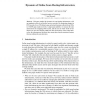Free Online Productivity Tools
i2Speak
i2Symbol
i2OCR
iTex2Img
iWeb2Print
iWeb2Shot
i2Type
iPdf2Split
iPdf2Merge
i2Bopomofo
i2Arabic
i2Style
i2Image
i2PDF
iLatex2Rtf
Sci2ools
PAM
2009
Springer
2009
Springer
Dynamics of Online Scam Hosting Infrastructure
This paper studies the dynamics of scam hosting infrastructure, with an emphasis on the role of fast-flux service networks. By monitoring changes in DNS records of over 350 distinct spam-advertised domains collected from URLs in 115,000 spam emails received at a large spam sinkhole, we measure the rates and locations of remapping DNS records, and the rates at which “fresh” IP addresses are used. We find that, unlike the short-lived nature of the scams themselves, the infrastructure that hosts these scams has relatively persistent features that may ultimately assist detection.
| Added | 20 May 2010 |
| Updated | 20 May 2010 |
| Type | Conference |
| Year | 2009 |
| Where | PAM |
| Authors | Maria Konte, Nick Feamster, Jaeyeon Jung |
Comments (0)

